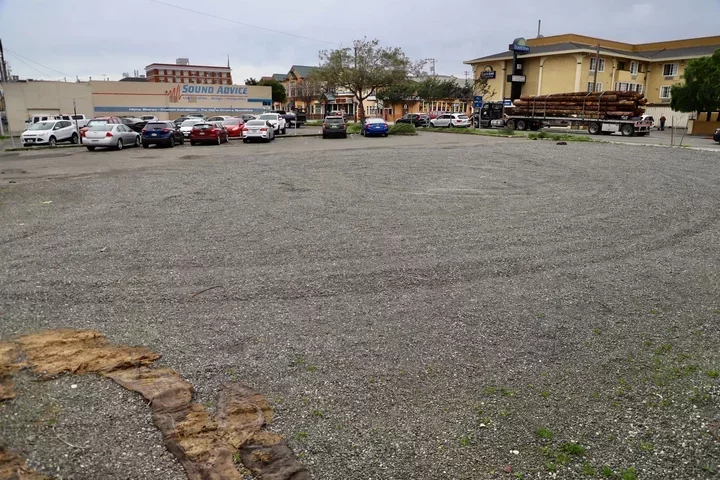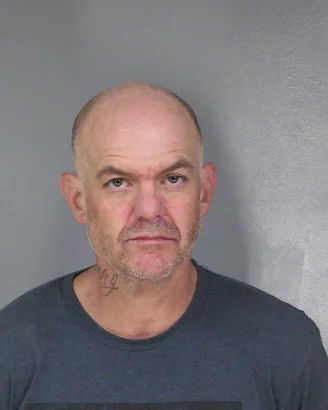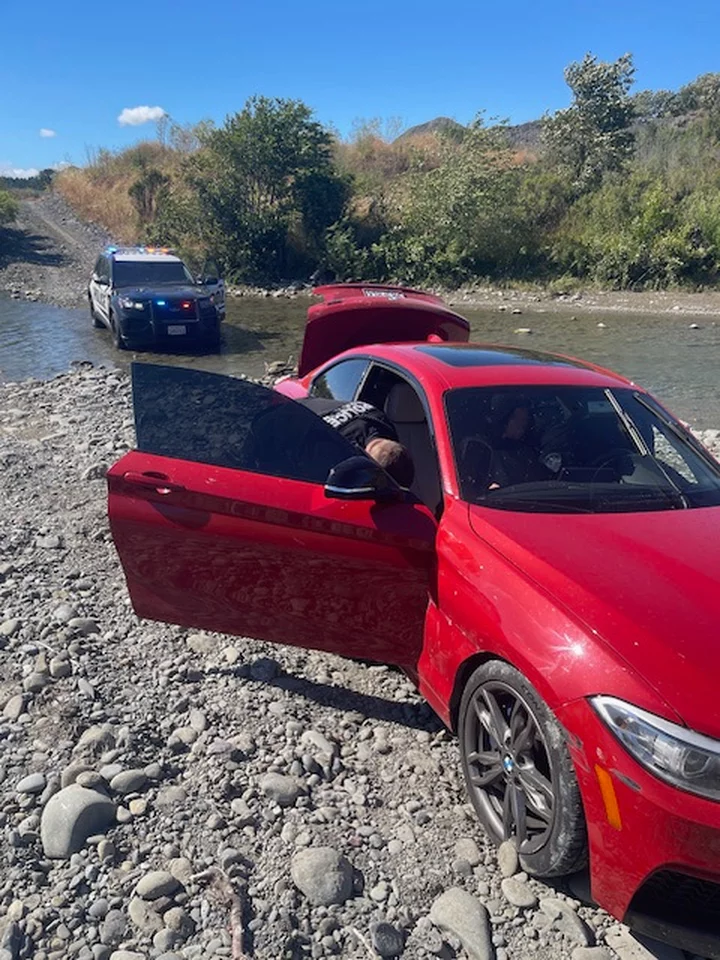OBITUARY: Robert Vernon Ford, 1931-2024
LoCO Staff / Tuesday, July 2, 2024 @ 6:56 a.m. / Obits
On May 2nd, 2024, Robert Vernon Ford, known affectionately as “Bob” and “Uncle Bob,” peacefully passed away at his home at Silvercrest in Eureka. He was 92 years old, born on November 3rd, 1931, in Willits.
Bob’s life was marked by his deep passion for fishing, a hobby he cherished throughout his years. Many Saturdays were spent with his fishing buddy, Gerald. When they weren’t fishing together, they would attend local events, creating cherished memories. Bob always had great stories about those Saturday adventures. Many times, “Uncle Bob” would spend time with his family over at Coffee Creek in Trinity County, where he would eagerly wait for someone in the family to be headed to the nearby fishing pond.
Beyond fishing, Bob had a lifelong love for flying, having served in the air force during the Korean War and later piloting a crop duster over the fields of Idaho. His commitment to community was evident through his twenty-year membership at the Humboldt Senior Resource Center, where he participated in their day program.
Throughout his later years, Bob formed close bonds with his caretakers Denise, Rachel, and Matt, who became like family to him, sharing holidays and special moments together. He was preceded in death by Linda Botsford, a cherished caregiver who held a special place in Bob’s heart.
Bob will be fondly remembered for his infectious sense of humor, his penchant for dressing up in holiday costumes, and his unwavering zest for life. He approached each day with generosity, kindness, and a deep appreciation for the joys life offered him. His warm smile and easy-going nature endeared him to all who knew him.
Bob is survived by his brother Wayne Ford, step-sister Janice Campbell, cousins Glenn Ford, Gary (Diane) Ford, and Delman (Donna) Ford, numerous second cousins, several great nieces and nephews, as well as numerous extended family throughout Humboldt and Mendocino Counties, alongside many close friends.
A Celebration of Life honoring Bob will be held on Saturday, July 27, 2024, at 2 p.m. at the Humboldt Bay Social Club, suitingly in “The Hangar,” located at 900 New Navy Base Rd. in Samoa.
###
The obituary above was submitted on behalf of Bob Ford’s loved ones. The Lost Coast Outpost runs obituaries of Humboldt County residents at no charge. See guidelines here.
BOOKED
Today: 11 felonies, 16 misdemeanors, 0 infractions
JUDGED
Humboldt County Superior Court Calendar: Today
CHP REPORTS
No current incidents
ELSEWHERE
Governor’s Office: Governor Newsom announces appointments 12.12.2025
County of Humboldt Meetings: Fish & Game Advisory Commission Agenda - Regular Meeting
Governor’s Office: TIME’s Person of the Year was Made in California
Governor’s Office: Governor Newsom visits LA recovery efforts in Altadena and the Palisades, views homes set to be completed soon
Rob Arkley Pursued Purchase of Jacobs Middle School Property Before Eureka City Schools Entered Land-Swap Deal With Secretive Corporation
Ryan Burns / Monday, July 1, 2024 @ 2:42 p.m. / Housing , Local Government
Rob Arkley in 2014. | File photo by Andrew Goff.
###
Security National founder and political lightning rod Rob Arkley was in discussions with Eureka City Schools about purchasing the vacant Jacobs Middle School campus before the district entered into a surprise land exchange agreement with a mysterious corporation called AMG Communities - Jacobs, LLC, which had been created just two days earlier.
“Prior to AMG’s successful bid for the property, Security National Properties communicated with the District as a potential buyer and also provided guidance regarding buying, selling, and managing properties,” Security National spokesperson Gail Rymer told the Outpost via email. “However … Security National Properties is not a buyer of the Jacobs property and is not involved with AMG Communities, nor is Rob Arkley.”
The revelation of Arkley’s involvement in negotiations with the district comes after the Outpost reviewed heavily redacted copies of the district’s communications in the months leading up to its board of trustees’ unexpected and controversial Dec. 14 decision to enter the land swap deal with AMG.
The 246 pages of documents turned over to the Outpost reveal that administrators and attorneys for Eureka City Schools exchanged dozens upon dozens of emails hammering out details of the agreement with AMG ahead of that December board meeting.
This runs contrary to what the district told the North Coast Journal back in March via attorney Harold Freiman of the Walnut Creek firm Lozano Smith. Freiman said a search for documents did not locate any correspondence to or from former Superintendent Fred Van Vleck that referenced a property exchange for the Jacobs site, AMG Communities-Jacobs LLC or any of its representatives — with a single exception.
As reported by the Journal’s Thadeus Greenson, the district’s records search found only this:
a text message to Van Vleck from school board President Susan Johnson, sent about 50 minutes before the board went into closed session on Dec. 14 to discuss the proposed property exchange for the first time, with a Lost Coast Outpost headline referring to the “mystery item” on that evening’s agenda. Van Vleck did not respond, according to the documents released to the Journal.
Asked to clarify, Freiman said no documents were found and withheld after being determined to be exempt from disclosure under public records law.
“Based on the document trail provided by the district, it’s as if the deal materialized out of thin air,” Greenson wrote.
Now we know that’s far from the truth. The Outpost submitted its own California Public Records Act request after reading the recent Humboldt County Civil Grand Jury report criticizing the district for its lack of transparency and for the Board of Trustees’ lack of due diligence before “rubber stamp[ing]” the deal.
The Grand Jury report notes that Bradley B. Johnson, a San Diego-based attorney who represents Security National and several other Arkley-affiliated organizations (as you’ll read more about below), “sent and received many emails [emphasis added] to and from ECS administrative staff and legal counsel regarding the Jacobs property real-estate transaction before and after the December 14, 2023, ECS trustee meeting.”
Those emails delve into such matters as parcel surveys, deeds, inspections, escrow, lease terms, revisions to contract language and more, though many of the details are hidden behind redactions.
Why weren’t those emails disclosed to the Journal?
Arielle Percival, another Lozano Smith attorney representing the district, offered the Outpost this explanation:
In Mr. Freiman’s conversation with Mr. Greenson, he indicated that he knew of no other communications responsive to Mr. Greenson’s request beyond materials that had been redacted or withheld for privilege, and that no other responsive materials had been located in Mr. Van Vleck’s emails. … [T]he Grand Jury invoked its subpoena power and gave assurances of confidentiality that led to some of the communications from and to my office later being provided to the Grand Jury, though those communications as provided still included redactions intended to continue to preserve the attorney-client privilege.
Whether or not that’s sufficient legal justification for denying the release of such communications in response to a Public Records Act request, the fact remains that Eureka City Schools was in regular contact with Security National’s go-to attorney, Johnson, in the weeks and months leading up to the Dec. 14 board meeting.
The California Highway Patrol had spent more than four years negotiating with the district to purchase the Jacobs property for $4 million. The agency was hoping to build its new Northern Humboldt headquarters there, relocating from Samoa Boulevard in Arcata to get out of the tsunami zone. The CHP had outbid the City of Eureka, which offered $2,818,000 for the property but bowed out when the asking price got too steep.
CHP personnel were reportedly caught off guard when the Eureka City Schools Board of Trustees voted unanimously to take another route altogether, one that had been kept almost entirely secret from the public until just 90 minutes before the board’s decision.
Following a closed session hearing with Van Vleck, who was attending his final meeting before retiring from the district, the board opted to trade the Jacobs property to AMG Communities - Jacobs, LLC, which had been created just 48 hours earlier. In exchange, the district is slated to receive a two-unit residential property on ⅛ of an acre on I Street, plus $5.35 million in cash.
The AMG offer is valued at $6 million, a full $2 million more than the CHP bid and more than twice what the City of Eureka was willing to pay.
The property at 3553 I Street contains two separate units. In an email to an attorney, Assistant Superintendent Paul Ziegler observed that the property “looked dated.” | Image via Eureka City Schools.
The transaction hinged on a clever use of the California Surplus Land Act, which allows government agencies to exchange “surplus property” with other parties while sidestepping a lot of red tape. In this case, the maneuver allowed Eureka City Schools to avoid a number of California Education Code requirements that are part of standard real estate deals with school districts. Thanks to the inclusion of the small residential property at 3553 I Street, which the district says it will use to house employees, this deal qualifies as a trade, even though the vast majority of the offer’s value comes via the millions in cash.
The documents provided to the Outpost show district administrators rushing to complete the deal before the end of the year while being careful not to release any information about it to the public until the last minute.
They also reveal that Johnson and the district initially had an altogether different property lined up for the land swap, a four-plex at 4242 Walnut Drive in Cutten. But on Nov. 28, barely two weeks before the board’s decision, Johnson informed the district that the seller of that property had backed out. Not to worry, though; Johnson had quickly lined up “an entirely different property for the exchange,” as Freiman later reported to Van Vleck and Assistant Superintendent Paul Ziegler.
Van Vleck (left) and Ziegler at a 2022 Eureka City Schools Board of Trustees meeting. | File photo by Andrew Goff.
###
On the morning of Dec. 12, just two days before the school board meeting, Freiman asked Johnson via email whether AMG actually existed.
“Not yet,” Johnson replied. “We are forming it today on the 24-hour turnaround.”
In its report published two weeks ago, the Grand Jury concluded that, prior to hastily agreeing to a $6 million property deal with such a newly created entity, “ECS Trustees did not publicly verify the bona fide identity and finances of AMG Communities-Jacobs, LLC.” The report also found that “Prior public notice failed to personally name the AMG Communities-Jacobs, LLC principal members or negotiator(s).”
To date, AMG has only provided the district with a $100,000 deposit. The deal remains in escrow, with a target closing date of July 11. More than six months after the exchange was arranged, the interests behind AMG Communities - Jacobs, LLC, remain a closely held corporate secret.
While AMG established a website (which currently features an aerial shot of the San Francisco Bay Area on its homepage, for some reason) and an email address where you can send inquiries, the people who respond to those inquiries have steadfastly refused to identify themselves or anyone else involved with the company, except to say in the website’s FAQ section, “Rob Arkley is not an owner or investor in AMG Communities.”
Even if that’s true — and currently we have only their word for it, and Arkley’s — there is ample connective tissue linking Arkley and Security National to a range of initiatives aimed at moving affordable housing development plans away from Eureka’s downtown and over onto the Jacobs property, which sits at the southern border of city limits.
The City of Eureka’s current development plans involve converting several municipal parking lots into apartment buildings to help satisfy state mandates for affordable housing.
Arkley has railed against these efforts for years, saying the developments would eradicate too many parking spaces. In angry exchanges with Eureka City Manager Miles Slattery and other staffers, Arkley has said the parking lots in question are “critical for safety” and “the lifeblood of downtown retail and restaurants.”
In late 2022, Arkley threatened to move Security National headquarters out of Eureka — a threat he has yet to follow through on. In a 2021 interview on KINS Radio’s “Talk Shop” he vowed to take legal and political action — namely lawsuits and a ballot initiative — aimed at thwarting the city’s plans.
Through Security National, he has done just that. Citizens for a Better Eureka, a nonprofit corporation financed by the company, filed a series of five lawsuits last year intended to halt affordable housing developments on four city-owned lots.
Security National is also footing the bill for the “Eureka Housing for All and Downtown Vitality” initiative, which will appear on the ballot in November. If passed, the measure will create new restrictions on 21 city-owned parking lots around town. Any housing developments on those lots would be required preserve the existing number of parking places and add new ones to accommodate residents, should they be deemed necessary.
Those requirements — which would be enshrined via an amendment to the city’s general plan creating an “Off-Street Public Parking (OSPP) Overlay Designation” — could render most of the city’s current affordable housing development plans infeasible. That includes the Linc Housing projects at Eighth and G and Sixth and M streets, which have received tens of millions of dollars in grant funding.
The parking lot at the corner of 5th and D streets (in the background) beyond the gravel lot where the Lloyd Building once stood. | File photo by Andrew Goff.
###
It should be pointed out that the measure includes an escape clause, of sorts, for one of those 21 municipal parking lots: the one at the corner of 5th and D streets. That’s the lot half a block from Security National’s 5th Street headquarters, and in recent years Arkley and his staff unsuccessfully tried to negotiate a number of deals to acquire it.
Currently, the Wiyot Tribe’s Dishgamu Humboldt Community Land Trust plans to build a multi-income housing development there, along with another high-density housing project a few blocks away, at 6th and L. The “Housing for All” initiative says those projects will be exempt from the measure’s parking requirements, but only if the Wiyot agency remains the bid awardee and developer.
If the Wiyot project falls through for any reason and the city decides to trade the 5th and D lot for another parcel, then the parking overlay “shall cease to apply,” the measure says, in which case the parcel could be developed with a wide range of commercial uses, including bars, retail, restaurants, car sales and more.
Meanwhile, glossy mailers paid for by Security National invite the public to “imagine what’s possible” at the Jacobs site. The “Housing for All” measure would enable that property to be rezoned to allow for high-density housing development, though critics, including Eureka City Councilmember Kati Moulton, have noted that the measure wouldn’t actually commit AMG or anyone else to developing even a single house. The zoning changes could instead open the door to strip malls, car lots, bars and numerous other types of commercial development.
Whoever is behind AMG Communities - Jacobs, LLC, they’re working symbiotically with Security National on Arkley’s plans for Eureka, spreading the same message as “Citizens for a Better Eureka” and the “Housing for All” initiative. According to AMG’s website, the corporation was formed “solely for the purpose of acquiring the former Jacobs Middle School site … and exploring ways to develop the site in the future.”
As pointed out by the Journal and, more recently, by the Humboldt County Civil Grand Jury, there’s one attorney handling who’s been handling all of this interrelated business: Bradley B. Johnson.
From the Grand Jury report:
- Bradley B. Johnson reportedly initiated contact with [Eureka City Schools] in August 2023 suggesting another purchaser for the Jacobs property (besides the City or … CHP) using the land exchange provision of the California Education Code.
- Bradley B. Johnson is listed as the Secretary and Chief Financial Officer of Citizens for a Better Eureka in the Statement of Information for the nonprofit corporation filed with the California Secretary of State in September 2023.
- Bradley B. Johnson, representing Citizens for a Better Eureka, funded by Security National, initiated five lawsuits against the City of Eureka.
- Bradley B. Johnson signed the Agreement for the sale of the Jacobs property to AMG Communities-Jacobs, LLC as an agent for AMG.
- Bradley B. Johnson’s company, Everview Ltd., is listed in escrow documents as the purchaser of the 3553 I Street property.
- Bradley B. Johnson is listed as the Manager of AMG Communities-Jacobs, LLC in the Statement of Information for the LLC filed with the California Secretary of State in April 2024.
- Bradley B. Johnson sent and received many emails to and from ECS administrative staff and legal counsel regarding the Jacobs property real-estate transaction before and after the December 14, 2023, ECS Trustee meeting.
You can now read many of those emails for yourself, albeit in heavily redacted form, by clicking the link below.
###
DOCUMENT: Redacted emails and documentation from Eureka City Schools
The Jacobs campus. | File photo by Andrew Goff.
PREVIOUSLY
- Who Will Get the Former Jacobs Campus? Bidders for Blighted Site in Highland Park Are the City of Eureka and the California Highway Patrol, With a Decision Coming Soon
- The CHP Would Like to Build New Headquarters on the Property Championed by People Opposing Downtown Housing Development, and There Was a Meeting About it Yesterday
- Open Letter Urging Eureka Voters Not to Sign the ‘Housing For All’ Petition Endorsed by 100+ Humboldt County Residents, Including Local Leaders in Politics, Business and Culture
- New Coalition — ‘I Like Eureka Housing!’ — Formed to Oppose Arkley-Backed Pro-Parking Lot Initiative
- Mystery Item on Tonight’s Eureka City School Agenda Suggests Imminent Action on Jacobs Campus, but the School District Won’t Share Details
- Eureka City Schools Board of Trustees Unanimously Votes for So-Called ‘Land Exchange’ With Mystery Developer
- The Eureka City Schools Board Voted on a Resolution Last Week That Was Not Published Before the Meeting. Is That Legal?
- At Town Hall Meeting, Frustrated Residents Discuss Future Development of Eureka’s Jacobs Campus; Mystery Developer Still Mysterious
- Security National Has Spent at Least $236,000 on the Pro-Parking ‘Housing for All’ Initiative So Far
- Grand Jury Slams Eureka City Schools For ‘Secretive’ Jacobs Campus Deal
- League of Women Voters Chimes in on Lack of Transparency in Eureka City Schools Property Transfer
Fortuna Police Arrest Wanted Chop-Shop Suspect After High Speed Chase Sunday
LoCO Staff / Monday, July 1, 2024 @ 2:14 p.m. / Crime
PREVIOUSLY:
###
Press release from the Fortuna Police Department:
On Sunday, June 30th 2024, at about 4:30 p.m., Fortuna Police Officers successfully apprehended Daniel Fidler, a suspect wanted for numerous felonies, after a high-speed chase that began near Fortuna and concluded off of Hwy 36 near Carlotta, California.
The pursuit initiated on Rohnerville Road after an officer observed Fidler driving his red BMW. Despite officer’s attempts to conduct an enforcement stop, Fidler accelerated, prompting the high-speed chase. Fidler evaded police with willful and wanton disregard for the safety of people or property. The pursuit went through Fortuna and Hydesville and ultimately ended on the river bar near Carlotta.
During the chase, Fidler’s vehicle reached speeds on the highway exceeding 90 mph. Fortuna PD officers deployed spike strips, successfully disabling one of Fidler’s tires which eventually disabled the BMW. Fidler drove his vehicle into the river and fled on foot.
Fidler was apprehended quickly and without further incident. Officers on scene reported a safe and successful conclusion to the pursuit.
Fidler was booked into the Humboldt County Jail for nine (9) felonies involving vehicle theft related crimes, weapon related crimes, and reckless evading. He was additionally booked on a felony warrant for kidnapping and an 836 PC Want for Reckless Evading out of the Humboldt County Sheriff’s Office.
The Fortuna Police Department commends the involved officers for their professionalism and dedication in safely apprehending a dangerous suspect. We also extend our gratitude to the community for their support and vigilance.
For further information, please contact Chief Casey Day at (707) 725-7550.
The Hiker Who was Found Injured on the Lost Coast Trail Last Week is Recovering and Thankful for His Rescuers
Jacquelyn Opalach / Monday, July 1, 2024 @ 1:24 p.m. / Emergencies
The view of sunset from the Lost Coast Trail on June 24. Screenshot of a video by Sashank Upadhyayula.
###
PREVIOUSLY:
###
Almost a week after being discovered with severe injuries and memory loss along the Lost Coast Trail, Sashank Upadhyayula is still trying to piece together what happened to him.
Upadhyayula, a 34-year-old first-time backpacker from San Jose, was found hypothermic and covered in blood by a group of six teens and two camp counselors on the morning of June 25th. The two adults dressed some of his wounds and called for helicopter rescue by satellite phone, and Upadhyayula was taken to a hospital and released the same day.
Upadhyayula told the Outpost in an email that he has wounds on his arms, torso and throat, and shared what he can remember of the moments before and after he was injured.
Around 10 p.m. on Monday, June 24, “I remember hearing something, being scared and removing my bear spray, my two knives, water reservoir and my electronics,” Upadhyayula said. Next he can recall, Upadhyayula woke up in the surf. “[I] made my way to the trail and collapsed after getting my mylar blanket. I covered my torso with the blanket and assumed fetal position to retain heat.”
He was found around 9 a.m. the next morning.
“The doctors believe that it was a knife [or] bladed weapon,” Upadhyayula said. “With my lack of memory and because my knives are missing and how I was separated from my pack and found quite a distance away […] it all points towards me being attacked.”
Upadhyayula reported the incident to the Humboldt County Sheriff’s Office and to the Bureau of Land Management (BLM) King Range National Conservation Area Office.
BLM King Range Area Manager Paul Sever told the Outpost that the Sheriff’s Office has opened an investigation. But at this time, there is “no reason to believe that there is any threat to public health or safety” along the Lost Coast Trail, Sever said.
The Sheriff’s Office didn’t respond to requests for comment. We’ll update if more information becomes available.
[CORRECTION: The Sheriff’s Office had, in fact, sent us this response, which slipped through our inbox this morning. Apologies.]
The HCSO is continuing to investigate this incident but there is currently no information to suggest there is any current/on-going threat to safety of the public along the Lost Coast Trail. As with any such remote/rural area, we encourage people to make sure they are adequately prepared for the rugged terrain of that area (adequate food, clothing, maps, GPS enabled location/emergency notification device) and as with anywhere, people should always be aware of their surroundings and report any suspicious activity/behavior to law enforcement.
“I just want to thank the people that helped rescue me and I want the other hikers in that area just to be aware of their surroundings and to make sure that nothing like this happens ever again,” Upadhyayula said.
To his rescuers, Upadhyayula added: “Thank you from the bottom of my heart. I cannot express my gratitude, you are doing God’s work. I hope you achieve your dreams. Happy trails!”
34-Year-Old Eureka Man Killed in Motorcycle Accident Near Redway
LoCO Staff / Monday, July 1, 2024 @ 11:40 a.m. / Traffic
California Highway Patrol release:
On June 29, 2024, at approximately 10:35 PM, Humboldt Communication Center (CHP Dispatch) received a 9-1-1 call of a crash involving a motorcycle on Redwood Drive, north of the community of Redway. Redway Volunteer Fire Department, City Ambulance, and CHP arrived on scene and provided life saving measures to the rider. The rider, Raul Villalobos, a 34-year-old Eureka resident, was transported to Jerold Phelps Medical Center in Garberville, where he was pronounced deceased. Villalobos was not wearing a helmet at the time of the crash.
A preliminary investigation shows Villalobos was riding his motorcycle northbound on Redwood Drive at a high rate of speed. Villalobos laid the motorcycle down, it left the roadway, and struck the embankment. The CHP Garberville Area Office is investigating the cause of the crash.
The California Highway Patrol wants to remind motorists the importance of wearing appropriate safety equipment while riding motorcycles, including Department of Transportation (DOT) approved helmets.
PREVIOUSLY:
Humboldt Area Foundation Board Announces Change of Leadership
LoCO Staff / Monday, July 1, 2024 @ 11:39 a.m. / Business
Lipper (left); Dronkers. Photos: HAF.
Press release from the Humboldt Area Foundation:
The Humboldt Area Foundation and Wild Rivers Community Foundation Board of Directors is excited to announce important changes in the organization’s leadership serving our beloved region:
Our Chief Executive Officer, Bryna Lipper, has been accepted to a distinguished PhD program at Carnegie Mellon University with a focus on climate change and social jus ce in rural and Indigenous communities. Her research will involve this region’s environmental and political history and pose future scenarios for climate justice. As such, Bryna will be stepping out of day-to-day management and assume the role of Chief Innovation Officer where she will collaborate at national and state levels to further partnerships, research, and public policy related to philanthropy supporting our Pacific Redwood Region.
Sara Dronkers will begin acting in the role of Chief Operating Officer immediately. Sara, with over 20 years of work experience at HAF+WRCF, has been involved in all functions of the Foundation’s remarkable growth and performance, from grantmaking, to finance, to donor development. Sara begins to oversee executive management in a me of the foundation’s history where grantmaking to the community is at record high levels, including a projected $12 million in the upcoming 2024/25 fiscal year. Sara has served as Chief of Staff of the foundation since 2020.
This growth is further grounded in the official appointment of Paula (Pimm) Tripp-Allen as Vice President of Programs, Community Partnerships, and Tribal Relations at the Foundation. Pimm will lead the organization’s grantmaking efforts, program and affiliates, and regional initiatives. Pimm, of Yurok and Karuk ancestry, will also continue leading Native American and Tribal Naion relations, and the Foundation’s activities furthering justice in Native communities. Long affiliated with the foundation, Pimm began more than two decades ago on staff for the Native Cultures Fund, then served on the Board of Directors for many years. Immediately prior to serving as Vice President, she served as Senior Advisor to the CEO for the past 2 years.
In addition to its strong vote of support for this leadership structure for the Foundation’s evolution, the Board of Directors voted unanimously to extend the terms of its Board Officers—including Chair Charlie Jordan, Vice Chair David Finigan, and Secretary Raquel Ortega—and its Committee Chair positions for up to a year for continuity to the staff and clarity to our community. Board Chair Jordan and Vice Chair Finigan shared the sentiment that:
“The board is excited that Bryna will continue to provide invaluable leadership and creativity to the foundation while she undertakes her doctorate program. Our foundation is in an excellent place as a result of the strategic work she accomplished during the past five years that has elevated our region statewide and nationally. The board is likewise extremely confident in and fortunate to have Sara Dronkers step into the top management role at the Foundation, given her many years of experience, community knowledge, and operational acumen. With our former board colleague Pimm Tripp-Allen as Vice President directing our program and grantmaking activities, we are certain that our highest values of service, equity, and responsibility within our region will prosper. The board also has the deepest gratitude and admiration for Sarah Millsap, Vice President of Finance and Administration, who steadfastly directs our fiduciary, investment, and budgetary duties with unparalleled ability and oversight; and Vice President of Advancement, Gina Zottola who provides the Foundation’s inspiration for charitable giving, legacy, and philanthropic partnerships that support our region’s goals and dreams. The Humboldt Area and Wild Rivers Foundation could not be be er poised for the future with this leadership team. The Board is confident that these leadership changes will fortify the Foundation’s commitment to growing a thriving, just, healthy and equitable region. We are poised for a future filled with opportunity and growth, guided by a team of inspiring leaders.”
Signed,
Charlie Jordan – Chair
David Finigan – Vice Chair
Raquel Ortega – Secretary
And the entire Board of Directors of Humboldt Area Foundation and Wild Rivers Community Foundation
Fire, Flood and Ice: Local Scientists Document Climate Threshold Crossed in the Klamath Mountains
Gillen Tener Martin / Monday, July 1, 2024 @ 11:05 a.m. / Environment
Justin Garwood in the Trinity Alps, fall 2022. Photo: Justin Garwood.
On a sweltering October day in 2022, Justin Garwood tucked a piece of glacial ice into his sleeping bag, carefully arranged clothes around the bundle, hiked 10 miles out of the Trinity Alps and stuck the chunk in his freezer, where it remains today.
“I don’t know what to do with it now,” he admitted.
The Trinities were once home to the lowest altitude, western-most glaciers in California: the Grizzly and the Salmon. But in 2015, after years of severe drought, the Grizzly Glacier broke apart and the Salmon disappeared entirely (or “went extinct,” in science-speak).

The now-extinct Salmon Glacier in the Trinity Alps in 2009 vs. 2015. Photos: Justin Garwood.
And in the fall of 2022 the Grizzly went extinct too.
“A certain climate supports glaciers, and we’ve left that,” said Garwood, an environmental scientist with the California Department of Fish & Wildlife, who described their loss as a “threshold crossed.”
California’s climate has long been “variable” in terms of precipitation (rain and snowfall), meaning swings from bone-dry to drenched-wet are nothing new. But warming is pushing that variability into overdrive, flatting four seasons into two: flood and drought, with drought growing ever longer.
“Some people call it the ‘climate vice,’ things are being put in a vice and squeezed,” Garwood said, “Snow is melting off sooner and coming later, so there’s less water on the landscape.”
An avid backpacker in the Klamath range and subranges (Siskiyous, Trinity Alps and Marbles) and co-editor of The Klamath Mountains: A Natural History, Garwood has been studying the effects of climate change in the mountains for years – as this Backpacker article chronicles. And, having grown up in Lewiston (east of Weaverville, west of Redding, at the edge of the Trinity Alps), he’s seen the region’s precipitation patterns change throughout his lifetime.
“When I was growing up, we used to get some decent snowstorms,” he said, “It wasn’t a big deal if two feet of snow fell at 2000 ft elevation.”
“Today, that’s a big deal,” he added.
Now, Garwood and climate scientist John P. O’Brien (also Trinity County-raised) are working on research that tells the story of the Grizzly’s final years – a sort of epilogue to glacial ice in the Klamath. But Garwood made clear that the disappearance of the glaciers, which were small to begin with, will not affect ecosystems as much as the shrinking of perennial snowfields in the range, such as those at Mirror Lake and Canyon Creek (both of which disappeared during the summers of 2013 and 2014).
“The elephant in the room isn’t the glaciers, it’s the loss of snow,” he said, explaining that the higher-altitude glaciers can be understood as a “canary in the coal mine” for what’s happening further down.
Increasing temperatures at higher altitudes are raising the snow line year by year, curtailing mountains’ abilities to act as ice chests for groundwater that is “metered out,” in Garwood’s words, during the dry summer months. These stores feed the rivers, lakes and reservoirs that provide crucial cold-water habitats for salmon and other species (as well as drinking water and electricity for humans, as O’Brien pointed out).
Melt is also occurring earlier in the year and faster – increasing flood risks during high precipitation years.
“Climate-driven megadrought” in the American West over the last two decades, which has marked the driest period on record in 1,200 years, has raised flood risks as well by making soil, trees and vegetation less able to soak up water.
(Parched landscapes tend more toward erosion and flooding during extreme precipitation events rather than beneficial water capture and retention.)

Vegetation change in the mountains above the Scott River, a tributary that feeds into the Klamath River, after years of drought (left: Dec. 1984, right: Dec. 2019). Images: Google Earth.
And (perhaps obviously), the less moisture gained and retained, the farther the severity and reach of fires will extend as “fuel conditions” (firefighter-speak for grasses, trees, branches and brush) increase in flammability.
“While we may see flooding in parts of the forest during the winter, the vegetation or ‘fuels’ will still dry out during the summer months. It’s not a question of ‘if’ fire will occur but rather ‘when,’” Adrianne Rubiaco, fire public affairs specialist with the Six Rivers National Forest, told the Outpost via email, “This is one of the reasons we are working with our federal, tribal, state, local and private partners to manage landscapes and reduce wildland fuels.”
The Red Salmon Complex Fire burns in the Trinity Alps Wilderness, 2020. Photo: Finn Scott-Neff.
Intensifying cycles of hotter, drier summers and shorter, more storm-filled winters explain why the forested montane areas of Northern California are predicted to experience up to a 400% increase in the average area burned annually by 2100, while the Shasta-Trinity National Forest expects a 300-400% increase in the frequency of 200-year flood events during the same period.
In climate-change-feedback-loop fashion, severe fires further alter water cycles by scorching the land, burning away moisture-absorbing vegetation and layering ash over snow and ice.
The River Complex Fire did just that in 2021, according to Garwood and O’Brien. Climbing the south face of Thompson Peak and burning at a higher elevation than any fire in recorded Klamath history, it rained ash down on Grizzly Glacier – accelerating the mass’s melt.

Scarred landscape surrounding Trail Gulch Lake, a popular backpacking spot in the Trinity Alps, after the River Complex Fires burned 199,343 acres in the summer of 2021 (left: July 2017, right: Mar. 2024). Images: Google Earth.
And while on Thompson, the tallest mountain in the Trinities, the River Complex also destroyed an ancient stand of whitebark pine (a federally “Threatened” species under the Endangered Species Act).
“These are not fire-adapted trees,” O’Brien said, explaining that because they grow at high elevations, whitebark pine haven’t had to face fire and lack the thick bark armor that protects their lower-altitude compatriots like redwoods and Douglas fir.
“The loss of this ancient subalpine stand is another local indicator of rapid climate change,” Garwood added.
Best practices for managing the cycles of extreme precipitation and hotter, drier summers that climate change is causing in the Klamath do not aim to stop fires entirely. On the contrary, prescribed burning has been known to decrease the severity of fires and has been carried out by the Karuk Tribe for thousands of years.
“Conducting prescribed burning on public land can release less volatile smoke and ash and reduces the potential risk to firefighters and people living in rural communities,” said Finn Scott-Neff, a lead forestry technician with a hotshot/handcrew out of Salyer.
The Red Salmon Complex Fire burns in the Trinity Alps Wilderness, 2020. Photo: Finn Scott-Neff.
While rains may have provided some respite from drought these last two winters, the loss of ice in the Klamath Mountains serves as a foreboding indicator that the range – and the ecosystems within it, developed alongside now-altered cycles of snowfall and melt – will continue to repay the debt that greenhouse gas emissions have written in California’s ledger during the coming seasons of fire and flood.
“Water has a non-negotiable freezing point. If you don’t get below that, you won’t get snow,” O’Brien said, “Warming temperatures push this ever uphill, every year.”
The Red Salmon Complex Fire burns in the Trinity Alps Wilderness, 2020. Photo: Finn Scott-Neff.


















